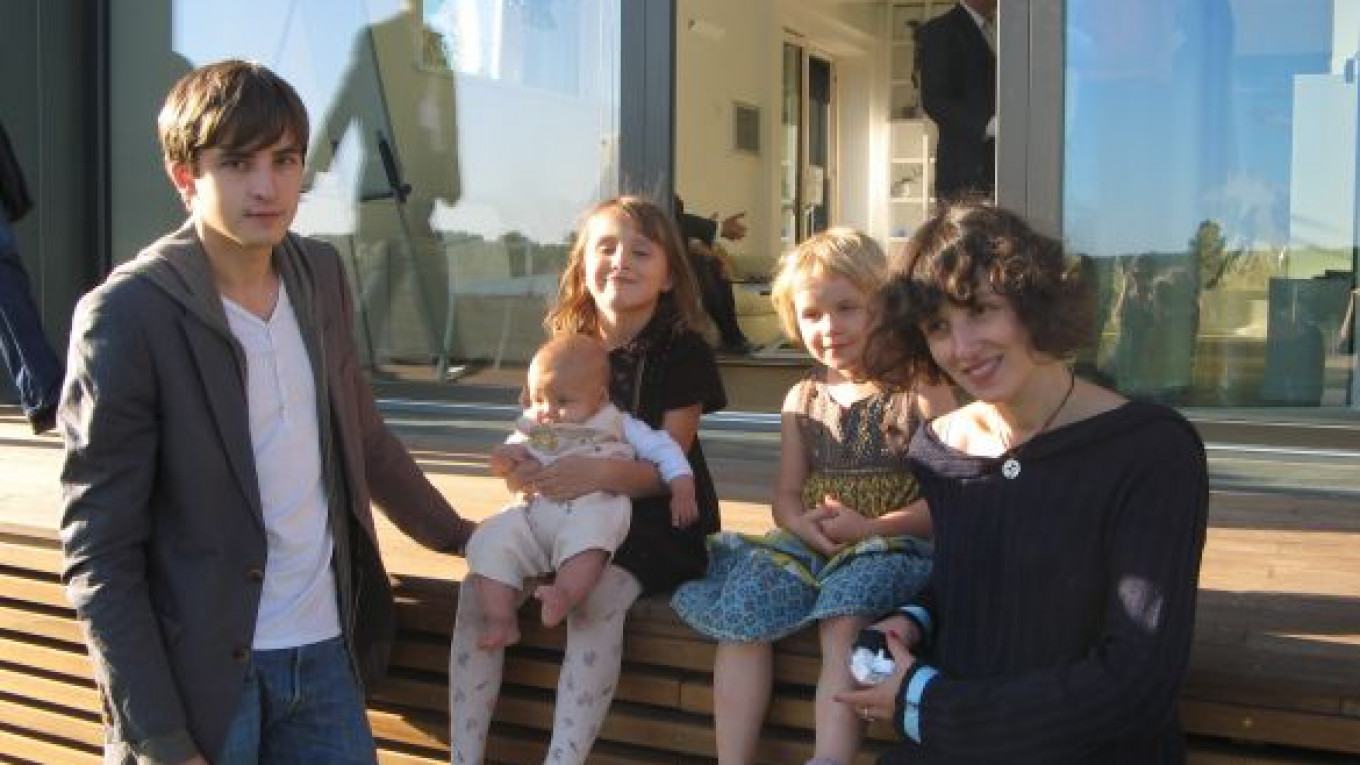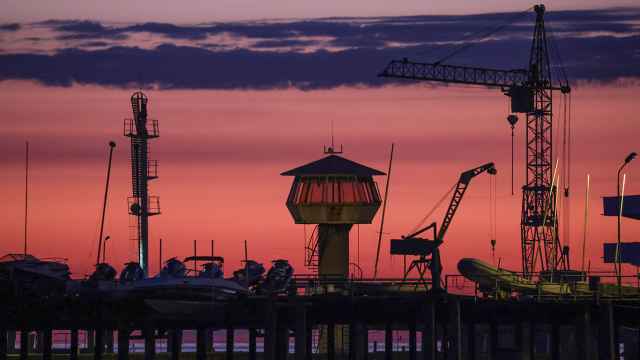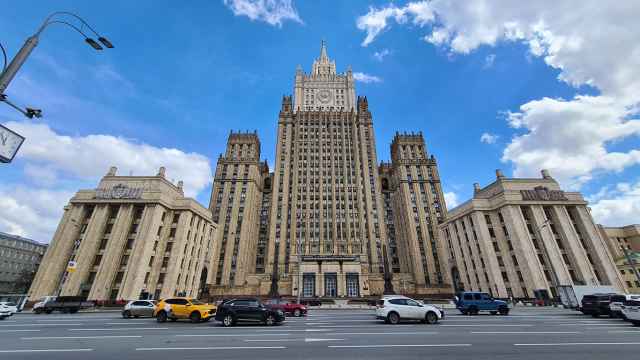A little blond girl in a short-sleeved green and blue dress appeared on the staircase of a massive wooden house with a red ribbon stretched across a big glass sliding door.
She pulled on the ribbon, swinging her white stuffed sheep on it and paying no attention to reporters and cameramen across the narrow road or the high-profile officials crowded at the house's entrance.
Four-year-old Polina Kronhaus is one of the residents of the newly constructed energy-efficient house outside Moscow, which she and her family moved into last week. Kremlin economic aide Arkady Dvorkovich and Crown Prince Frederik of Denmark handed over the keys.
The house, completed earlier this month, is located in a housing development 20 kilometers southwest of the capital.
It was built in line with the international Active House concept, using energy-efficient technologies to provide a healthy climate indoors while reducing the impact on the environment. It is considered a breakthrough in the country's residential construction.
A collaboration of Russian, French and Danish companies, the house cost 28.5 million rubles (almost $1 million) to build. Including interior and landscape design costs, the total outlay reached some 40 million rubles, said Oleg Panitkov, head of development at Velux, a Moscow-based unit of Danish skylight maker Velux Group, which participated in the construction.
The project was expensive, said Dmitry Aksyonov, owner of developer Zagorodny Proyekt, which built the house. But maintenance costs were the key concern, he said, because the home is a trial project.
"We didn't count the money here. It's like a concept car with all the high technologies used, and the construction costs were the last thing we were interested in," he told a news conference ahead of the opening.
According to Panitkov, the house, whose overall area is 230 square meters, will require lower maintenance expenses than traditional homes.
The annual cost of hot water and heating is expected to be 12,556 rubles — compared with 24,000 rubles in a house using gas and 217,000 rubles in a house heated with electricity.
The lower maintenance costs are achieved via solar panels and a geothermal pump using the Earth's natural heat to provide heating.
This will make it possible to reduce annual energy consumption for heating by almost 75 percent, compared with an ordinary home, to 38 kilowatt hours per square meter, according to a statement by Velux and Zagorodny Proyekt. The house, whose interior, including furniture, was designed in white to provide more light, is also equipped with a special system to control the inside temperature and air circulation.
The house might be sold in a couple of years, "if someone buys it," Aksyonov said. He declined to specify the possible price, saying only that such a residence should be affordable. The price for other Zagorodny Proyekt cottages in the settlement where the Active House is located start at 10 million rubles.
While 28.5 million rubles is the highest possible construction cost on the property market around Moscow, costs would be 20 percent to 25 percent lower if mass construction of similar homes started, said Dmitry Khalin, managing partner at IntermarkSavills.
If the property is put up for sale, a price of about $1 million is realistic, given its size and location, he said by telephone, adding that a buyer is unlikely to see a return on investments from lower maintenance costs alone.
But the property has good prospects from the economic point of view, as utility tariffs are likely to grow in the future because of Russia's impending accession to the World Trade Organization.
"The house is a bit ahead of its time. But in five to seven years, maintenance costs will be a significant factor," Khalin said.
Energy-efficient homes could also be popular among expats. Foreigners who are already familiar with energy-efficiency technologies in housing construction might be the best target audience to rent such properties in Russia, he said.
Similar projects are being implemented in a number of European countries, including Denmark, Britain and Germany.
Meanwhile, the Active House is not the only energy-efficient home in Russia. Construction on a similar house in Nazaryevo, the Moscow region's northwest, was completed last year.
The property, called Green Balance, will allow a savings of 32,850 rubles in heating costs per year, according to estimates by Rockwool, a producer of construction materials that contributed to the project.
Building the Active House could be the first step toward creating principles of sustainable construction in the country, said Andrei Bokov, president of the Union of Architects of Russia.
Russia needs to develop its own sustainable construction principles taking into account world practices and specific local conditions, Bokov said, adding that there are no such norms in the current legislation.
His union, along with other nongovernmental organizations, plans to draft sustainable construction standards for Russia in the next several years to allow for the development of construction projects that preserve the environment and create comfortable living conditions, he told reporters last week.
The technologies used to build the house will be subsequently applied to develop similar projects at a lower price, Aksyonov said.
"It will be much more affordable in three years," he said, adding that people will be ready to pay for the light and comfort.
He also said similar homes could be built in the regions.
Meanwhile, Polina Kronhaus, the little girl, was not the only one excited about her new home.
"I like the house very much, it exceeded all my expectations," said her mother, Asya Dunayevskaya. "The windows are huge, there's a lot of space, and it has a feeling of freedom," she said in a short interview after the ceremony.
The family will be testing the house for a year, sharing their impressions with the companies involved.
Dunayevskaya, a 30-year-old journalist, said she and her husband found the project's organizers by themselves and proposed testing the property.
"I'm a bit scared of what the children will make it look like, but so far it's great," she said, smiling.
A Message from The Moscow Times:
Dear readers,
We are facing unprecedented challenges. Russia's Prosecutor General's Office has designated The Moscow Times as an "undesirable" organization, criminalizing our work and putting our staff at risk of prosecution. This follows our earlier unjust labeling as a "foreign agent."
These actions are direct attempts to silence independent journalism in Russia. The authorities claim our work "discredits the decisions of the Russian leadership." We see things differently: we strive to provide accurate, unbiased reporting on Russia.
We, the journalists of The Moscow Times, refuse to be silenced. But to continue our work, we need your help.
Your support, no matter how small, makes a world of difference. If you can, please support us monthly starting from just $2. It's quick to set up, and every contribution makes a significant impact.
By supporting The Moscow Times, you're defending open, independent journalism in the face of repression. Thank you for standing with us.
Remind me later.






